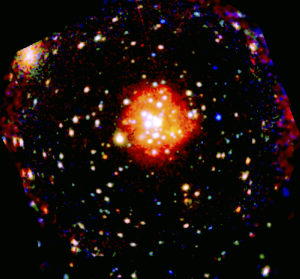X-RAYING A GALAXY’S STELLAR REMNANTS__X-ray kaleidoscope
This colourful spread of light specks is in fact a record of extremely powerful phenomena taking place in a galaxy known as Messier 83, or M83. Located some 15 million light-years away, M83 is a barred spiral galaxy, not dissimilar in shape from our own Milky Way, and currently undergoing a spur of star formation, with a handful of new stars being born every year.

X-RAYING A GALAXY’S STELLAR REMNANTS
While the starry pattern of spiral arms is barely visible in this X-ray view obtained by ESA’s XMM-Newton space observatory, this kaleidoscopic image tells a different story about the stellar remnants in this galaxy.
Most of the dots in this view represent the end points of the life cycle of stars, including remnants of supernova explosions and binary systems featuring compact stellar remnants like neutron stars or black holes that are feeding on matter from a companion star. In particular, the large speck to the lower left of the galaxy’s central region is what astronomers call an ultra-luminous X-ray source, or ULX, a binary system where the compact remnant is accreting mass from its companion at a much higher rate than an ordinary X-ray binary.
The highly energetic phenomena that can be observed with X-ray telescopes often undergo regular changes, on time scales of days or even hours, turning the X-ray sky into a spectacular light show. An animated version of this image, based on XMM-Newton data gathered on six occasions – January 2003, January and August 2014, February and August 2015, and January 2016 – is available here.
The sources located in the reddish area at the centre of the image correspond to objects located in the inner portions of M83. The majority of sources scattered across the image are located in the outskirts of the galaxy, but a few of those are foreground stars in our own galaxy, and others correspond to more distant galaxies in the background.
This RGB image combines nine XMM-Newton observations performed between 2003 and 2016 at energies of 0.2–2 keV (shown in red), 2–4.5 keV (shown in green), and 4.5–12 keV (shown in blue).
A study of 189 X-ray sources in M83, based on data from XMM-Newton, was presented in a paper by L. Ducci and collaborators in 2013.
Source: European Space Agency
- 214 reads
Human Rights
Ringing FOWPAL’s Peace Bell for the World:Nobel Peace Prize Laureates’ Visions and Actions

Protecting the World’s Cultural Diversity for a Sustainable Future

The Peace Bell Resonates at the 27th Eurasian Economic Summit

Declaration of World Day of the Power of Hope Endorsed by People in 158 Nations

Puppet Show I International Friendship Day 2020

